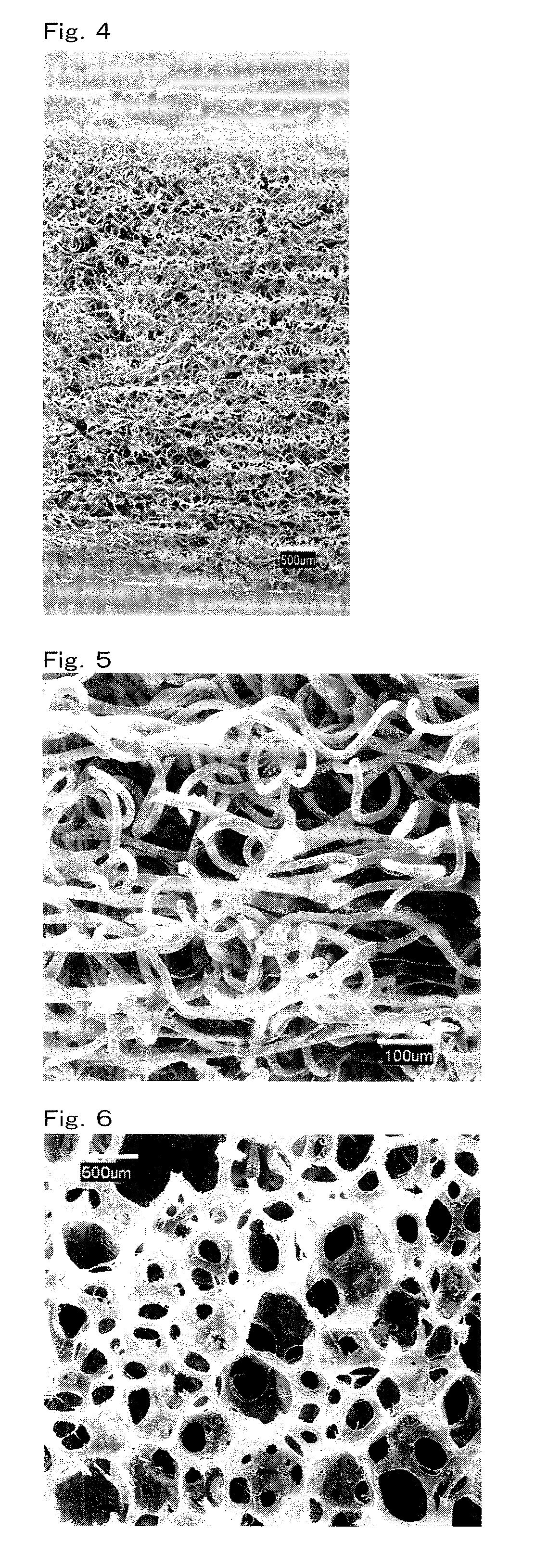Buffer substrate and use thereof
a buffer substrate and substrate technology, applied in the field of buffer substrates, can solve the problems of insufficient hand or handle texture, poor air permeation, excessive elasticity of foam urethane, etc., and achieve excellent cushioning properties, excellent softness, and excellent permeability.
- Summary
- Abstract
- Description
- Claims
- Application Information
AI Technical Summary
Benefits of technology
Problems solved by technology
Method used
Image
Examples
example 1
[0275]A Sheath-Core Structure Conjugated Staple Fiber (“Sofista” manufactured by Kuraray Co., Ltd., having a fineness of 3 dtex, a fiber length of 51 mm, a sheath-core mass ratio of 50 / 50, a number of crimps of 21 / 25 mm, and a degree of crimp of 13.5%) was prepared as a thermal adhesive fiber under moisture. The core component of the conjugated staple fiber comprised a poly(ethylene terephthalate) and the sheath component of the conjugated staple fiber comprised an ethylene-vinyl alcohol copolymer (having an ethylene content of 44 mol % and a degree of saponification of 98.4 mol %).
[0276]A side-by-side structure conjugated staple fiber (“PN-780” manufactured by Kuraray Co., Ltd., having a fineness of 1.7 dtex, a fiber length of 51 mm, a number of mechanical crimps of 12 / 25 mm, and a number of crimps of 62 / 25 mm after a heat treatment at 130° C. for one minute) was prepared as a potential crimping fiber. The conjugated fiber comprised a poly(ethylene terephthalate) resin (A component...
example 2
[0285]In the same manner as in Example 1 except for blending the thermal adhesive fiber under moisture and the potential crimping conjugated fiber with each other in the proportion (mass ratio) (the former / the latter) of 10 / 90, a fiber assembly (buffer substrate) was obtained. The results are shown Table 1.
example 3
[0286]In the same manner as in Example 1 except for blending the thermal adhesive fiber under moisture and the potential crimping conjugated fiber with each other in the proportion (mass ratio) (the former / the latter) of 60 / 40, a fiber assembly (buffer substrate) was obtained. The results are shown Table 1.
PUM
| Property | Measurement | Unit |
|---|---|---|
| apparent density | aaaaa | aaaaa |
| apparent density | aaaaa | aaaaa |
| apparent density | aaaaa | aaaaa |
Abstract
Description
Claims
Application Information
 Login to View More
Login to View More - R&D
- Intellectual Property
- Life Sciences
- Materials
- Tech Scout
- Unparalleled Data Quality
- Higher Quality Content
- 60% Fewer Hallucinations
Browse by: Latest US Patents, China's latest patents, Technical Efficacy Thesaurus, Application Domain, Technology Topic, Popular Technical Reports.
© 2025 PatSnap. All rights reserved.Legal|Privacy policy|Modern Slavery Act Transparency Statement|Sitemap|About US| Contact US: help@patsnap.com



